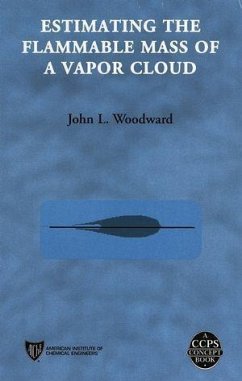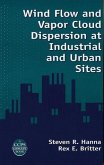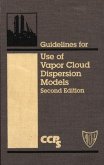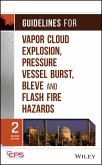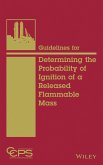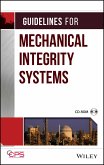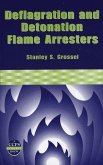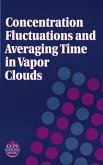John L. Woodward
Estimating the Flammable Mass of a Vapor Cloud (eBook, PDF)
185,99 €
185,99 €
inkl. MwSt.
Sofort per Download lieferbar

0 °P sammeln
185,99 €
Als Download kaufen

185,99 €
inkl. MwSt.
Sofort per Download lieferbar

0 °P sammeln
Jetzt verschenken
Alle Infos zum eBook verschenken
185,99 €
inkl. MwSt.
Sofort per Download lieferbar
Alle Infos zum eBook verschenken

0 °P sammeln
John L. Woodward
Estimating the Flammable Mass of a Vapor Cloud (eBook, PDF)
- Format: PDF
- Merkliste
- Auf die Merkliste
- Bewerten Bewerten
- Teilen
- Produkt teilen
- Produkterinnerung
- Produkterinnerung

Bitte loggen Sie sich zunächst in Ihr Kundenkonto ein oder registrieren Sie sich bei
bücher.de, um das eBook-Abo tolino select nutzen zu können.
Hier können Sie sich einloggen
Hier können Sie sich einloggen
Sie sind bereits eingeloggt. Klicken Sie auf 2. tolino select Abo, um fortzufahren.

Bitte loggen Sie sich zunächst in Ihr Kundenkonto ein oder registrieren Sie sich bei bücher.de, um das eBook-Abo tolino select nutzen zu können.
This CCPS Concept book shows designers and operators of chemical facilities how to realistically estimate the flammable mass in a cloud of accidentally released material that is capable of igniting. It provides information on industry experience with flammable vapor clouds, basic concepts of fires and explosions, and an overview of related computer programs.
- Geräte: PC
- ohne Kopierschutz
- eBook Hilfe
Andere Kunden interessierten sich auch für
![Wind Flow and Vapor Cloud Dispersion at Industrial and Urban Sites (eBook, PDF) Wind Flow and Vapor Cloud Dispersion at Industrial and Urban Sites (eBook, PDF)]() Steven R. HannaWind Flow and Vapor Cloud Dispersion at Industrial and Urban Sites (eBook, PDF)185,99 €
Steven R. HannaWind Flow and Vapor Cloud Dispersion at Industrial and Urban Sites (eBook, PDF)185,99 €![Guidelines for Use of Vapor Cloud Dispersion Models (eBook, PDF) Guidelines for Use of Vapor Cloud Dispersion Models (eBook, PDF)]() Ccps (Center For Chemical Process Safety)Guidelines for Use of Vapor Cloud Dispersion Models (eBook, PDF)193,99 €
Ccps (Center For Chemical Process Safety)Guidelines for Use of Vapor Cloud Dispersion Models (eBook, PDF)193,99 €![Guidelines for Vapor Cloud Explosion, Pressure Vessel Burst, BLEVE, and Flash Fire Hazards (eBook, PDF) Guidelines for Vapor Cloud Explosion, Pressure Vessel Burst, BLEVE, and Flash Fire Hazards (eBook, PDF)]() Ccps (Center For Chemical Process Safety)Guidelines for Vapor Cloud Explosion, Pressure Vessel Burst, BLEVE, and Flash Fire Hazards (eBook, PDF)139,99 €
Ccps (Center For Chemical Process Safety)Guidelines for Vapor Cloud Explosion, Pressure Vessel Burst, BLEVE, and Flash Fire Hazards (eBook, PDF)139,99 €![Guidelines for Determining the Probability of Ignition of a Released Flammable Mass (eBook, PDF) Guidelines for Determining the Probability of Ignition of a Released Flammable Mass (eBook, PDF)]() Ccps (Center For Chemical Process Safety)Guidelines for Determining the Probability of Ignition of a Released Flammable Mass (eBook, PDF)92,99 €
Ccps (Center For Chemical Process Safety)Guidelines for Determining the Probability of Ignition of a Released Flammable Mass (eBook, PDF)92,99 €![Guidelines for Mechanical Integrity Systems (eBook, PDF) Guidelines for Mechanical Integrity Systems (eBook, PDF)]() Ccps (Center For Chemical Process Safety)Guidelines for Mechanical Integrity Systems (eBook, PDF)163,99 €
Ccps (Center For Chemical Process Safety)Guidelines for Mechanical Integrity Systems (eBook, PDF)163,99 €![Deflagration and Detonation Flame Arresters (eBook, PDF) Deflagration and Detonation Flame Arresters (eBook, PDF)]() Stanley S. GrosselDeflagration and Detonation Flame Arresters (eBook, PDF)136,99 €
Stanley S. GrosselDeflagration and Detonation Flame Arresters (eBook, PDF)136,99 €![Concentration Fluctuations and Averaging Time in Vapor Clouds (eBook, PDF) Concentration Fluctuations and Averaging Time in Vapor Clouds (eBook, PDF)]() David J. WilsonConcentration Fluctuations and Averaging Time in Vapor Clouds (eBook, PDF)136,99 €
David J. WilsonConcentration Fluctuations and Averaging Time in Vapor Clouds (eBook, PDF)136,99 €-
-
-
This CCPS Concept book shows designers and operators of chemical facilities how to realistically estimate the flammable mass in a cloud of accidentally released material that is capable of igniting. It provides information on industry experience with flammable vapor clouds, basic concepts of fires and explosions, and an overview of related computer programs.
Dieser Download kann aus rechtlichen Gründen nur mit Rechnungsadresse in D ausgeliefert werden.
Produktdetails
- Produktdetails
- Verlag: John Wiley & Sons
- Erscheinungstermin: 17. September 2010
- Englisch
- ISBN-13: 9780470935354
- Artikelnr.: 38208358
- Verlag: John Wiley & Sons
- Erscheinungstermin: 17. September 2010
- Englisch
- ISBN-13: 9780470935354
- Artikelnr.: 38208358
- Herstellerkennzeichnung Die Herstellerinformationen sind derzeit nicht verfügbar.
JOHN L. WOODWARD, PhD, is Senior Principal Consultant in the Process Safety Division of Baker Engineering and Risk Consultants, Inc. in San Antonio, Texas. He has been actively involved in consequence modeling for both the DNV PHAST and BakerRisk SafeSite codes for many years. He was invited by the GAO as part of a team of LNG experts to review LNG safety issues.
Preface.
Acknowledgments.
Glossary.
Nomenclature.
1. Introduction.
1.1 Why Calculate Flammable Mass?
1.2 How Are Flammable Mass Estimates Used?
1.3 Other CCPS Publications.
2. Overview.
2.1 Context.
2.2 Objectives.
2.3 How to Use Thus Book.
3. Industry Experiences with Flammable Vapor Clouds.
3.1 Property Losses from Vapor Cloud Accidents.
3.2 Examples of Vapor Clouds Events.
3.2.1 Bangkok, Thailand, LPG Vapor Cloud.
3.2.2 Saint Herblain, France, Gasoline Cloud, October 7, 1991.
3.2.3 Pampa, Texas, Hoechst-Celanese Explosion, November 17, 1987.
3.2.4 Monsanto Ethanol Explosion, Autumn, 1970.
3.2.5 Mexico City Vapor Cloud and Explosion, November 19, 1984.
3.2.6 Pasadena, Texas Fire and Explosion, October 23, 1989.
3.3 Examples with Postaccident Determination of Flammable Mass.
3.3.1 Fixborough Vapor Cloud Explosion, June 1, 1974.
3.3.2 Piper Alpha North Sea Platform Fire, July 6, 1988.
3.3.3 DSM Naphtha Cracker, Beek, the Netherlands, 7 November 1975.
4. Basic Concept-Fluid Flow, Fires, and Explosions.
4.1 Discharge Characteristics.
4.1.1 Single-Phase Discharge Rates from Tanks.
4.1.2 Single-Phase Discharge Rates from Pipes.
4.1.3 Two-Phase Discharge Rates from Tanks.
4.1.4 Two-Phase Discharge Rates from Pipes.
4.1.5 Aerosol Formation and Drop Size Correlations.
4.1.6 Rainout.
4.1.7 Pool Spread and Evaporation on Land.
4.2 Dispersion Factors.
4.2.1 Jet Mixing.
4.2.2 Meteorology.
4.2.3 Surface Roughness and Terrain.
4.2.4 Averaging Time.
4.2.5 Impingement and Catering.
4.2.6 Obstacle Effects.
4.3 Sources of Ignition.
4.4 Flame Characteristics.
4.4.1 Flammable Limits.
4.4.2 Flammable Limits with Inerts.
4.4.3 Autoignition Temperature for Gases.
4.4.4 Minimum Ignition Energy for Gases.
4.4.5 Flash Point.
4.4.6 Laminar Burning Velocity and Turbulent Flame Speed.
4.5 Aerosol Flammability.
4.6 Turbulence Effects.
4.6.1 Turbulence Effects of Jet Plume Ignition.
4.6.2 Turbulence and Pockets of Flammable Material.
4.7 Flash Fires.
4.8 Explosions.
4.8.1 Confinement and Congestion.
4.8.2 Effects of Concentration on Explosion Overpressure.
4.8.3 TNT Equivalence Explosion Models.
4.8.4 Volume Source Explosion Models.
4.8.5 Determining Fuel Reactivity.
4.8.6 Determining Degree of Confinement.
4.8.7 Determining Level of Congestion.
4.8.8 Multiple Congested Volumes.
4.9 Minimum Flammable Mass for Vapor Cloud Explosions.
4.10 Probability of Vapor Cloud Ignition and Explosion.
5. Determination of Flammable Mass.
5.1 Estimation Methods by Degree of Confinement.
5.2 Methods for Finding the Flammable Mass in Unconfined Vapor Clouds.
5.2.1 Screening Rules of Thumb.
5.2.2 Calculating Flammable Mass with Dispersion Models.
5.3 Methods for Finding the Flammable Mass in Partially Confined Vapor
Clouds.
5.3.1 Estimating Flammable Mass for Potential Explosion Sites.
5.4 Methods for Finding the Flammable Mass in Confined Vapor Clouds.
5.4.1 Flammable Mass in Well-Mixed Room from Spill Outdoors.
5.4.2 Flammable Mass from Indoor Release in Well-Mixed Room with Low
Ventilation.
6. Overview of Related Computer Programs.
7. Worked Examples.
7.1 Example 10, Unconfined Vapor Cloud-Vapor and Liquid Propane Releases.
7.2 Example 11, Unconfined Vapor Cloud-Effect of Wind Speed.
7.3 Example 12, Partially Confined Vapor Cloud Explosion-Vinyl Chloride
Monomer Release.
7.4 Example 13, Partially Confined Vapor Cloud Explosion-Total Petroleum
LaMede Refinery Explosion, November 1992.
7.5 Example 14, Partially Confined Vapor Cloud-Multiple Congested Areas.
7.6 Example 15, Confined Vapor Clouds.
8. Recommendations for Future Work.
8.1 Calculating Flammable Mass Profiles Along a Vapor Cloud.
8.2 Resolving the Minimum Explosive Mass Issue.
8.3 Contribution of Aerosols to Explosive Mass.
8.4 Dispersion Modeling Around Plant Structure.
8.5 Improved Modeling of Jets Impacting Surfaces.
8.6 Models That Account for Turbulence Spectra.
8.7 Reconciling Indoor and Outdoor Explosion Models.
8.8 Calculate Net Efficiencies for TNT Equivalent Models from Historical
Events.
Appendix A. Atmosphere Stability Classification Schemes.
Appendix B. Vertical Wind Profiles.
Appendix C. Flammability Properties.
Appendix D. Correlation for Flash Point.
Appendix E. Polydisperse Drop Size Distributions.
Appendix F. Multicomponent Pool Evaporation for Spills on Land.
Appendix G. Generalized Indoor Concentration Build-Up or Decay.
Appendix H. Calculating Concentration for Indoor Releases.
Appendix I. Evaluating Flammable Mass for Gaussian Dispersion Models:
Instantaneous, Point Source.
Appendix J. Evaluating Flammable Mass for Gaussian Dispersion Models:
Continous Release, Approximate Method.
Appendix K. Evaluating Flammable Mass for Gaussian Dispersion
Model-Continuous Release, Rigorous Solution.
Appendix L. Numerical Integration to Find Flammable Mass.
Appendix M. Expansion Velocity and Discharge Coefficients.
Appendix N. Conversion Factors.
References.
Index.
Acknowledgments.
Glossary.
Nomenclature.
1. Introduction.
1.1 Why Calculate Flammable Mass?
1.2 How Are Flammable Mass Estimates Used?
1.3 Other CCPS Publications.
2. Overview.
2.1 Context.
2.2 Objectives.
2.3 How to Use Thus Book.
3. Industry Experiences with Flammable Vapor Clouds.
3.1 Property Losses from Vapor Cloud Accidents.
3.2 Examples of Vapor Clouds Events.
3.2.1 Bangkok, Thailand, LPG Vapor Cloud.
3.2.2 Saint Herblain, France, Gasoline Cloud, October 7, 1991.
3.2.3 Pampa, Texas, Hoechst-Celanese Explosion, November 17, 1987.
3.2.4 Monsanto Ethanol Explosion, Autumn, 1970.
3.2.5 Mexico City Vapor Cloud and Explosion, November 19, 1984.
3.2.6 Pasadena, Texas Fire and Explosion, October 23, 1989.
3.3 Examples with Postaccident Determination of Flammable Mass.
3.3.1 Fixborough Vapor Cloud Explosion, June 1, 1974.
3.3.2 Piper Alpha North Sea Platform Fire, July 6, 1988.
3.3.3 DSM Naphtha Cracker, Beek, the Netherlands, 7 November 1975.
4. Basic Concept-Fluid Flow, Fires, and Explosions.
4.1 Discharge Characteristics.
4.1.1 Single-Phase Discharge Rates from Tanks.
4.1.2 Single-Phase Discharge Rates from Pipes.
4.1.3 Two-Phase Discharge Rates from Tanks.
4.1.4 Two-Phase Discharge Rates from Pipes.
4.1.5 Aerosol Formation and Drop Size Correlations.
4.1.6 Rainout.
4.1.7 Pool Spread and Evaporation on Land.
4.2 Dispersion Factors.
4.2.1 Jet Mixing.
4.2.2 Meteorology.
4.2.3 Surface Roughness and Terrain.
4.2.4 Averaging Time.
4.2.5 Impingement and Catering.
4.2.6 Obstacle Effects.
4.3 Sources of Ignition.
4.4 Flame Characteristics.
4.4.1 Flammable Limits.
4.4.2 Flammable Limits with Inerts.
4.4.3 Autoignition Temperature for Gases.
4.4.4 Minimum Ignition Energy for Gases.
4.4.5 Flash Point.
4.4.6 Laminar Burning Velocity and Turbulent Flame Speed.
4.5 Aerosol Flammability.
4.6 Turbulence Effects.
4.6.1 Turbulence Effects of Jet Plume Ignition.
4.6.2 Turbulence and Pockets of Flammable Material.
4.7 Flash Fires.
4.8 Explosions.
4.8.1 Confinement and Congestion.
4.8.2 Effects of Concentration on Explosion Overpressure.
4.8.3 TNT Equivalence Explosion Models.
4.8.4 Volume Source Explosion Models.
4.8.5 Determining Fuel Reactivity.
4.8.6 Determining Degree of Confinement.
4.8.7 Determining Level of Congestion.
4.8.8 Multiple Congested Volumes.
4.9 Minimum Flammable Mass for Vapor Cloud Explosions.
4.10 Probability of Vapor Cloud Ignition and Explosion.
5. Determination of Flammable Mass.
5.1 Estimation Methods by Degree of Confinement.
5.2 Methods for Finding the Flammable Mass in Unconfined Vapor Clouds.
5.2.1 Screening Rules of Thumb.
5.2.2 Calculating Flammable Mass with Dispersion Models.
5.3 Methods for Finding the Flammable Mass in Partially Confined Vapor
Clouds.
5.3.1 Estimating Flammable Mass for Potential Explosion Sites.
5.4 Methods for Finding the Flammable Mass in Confined Vapor Clouds.
5.4.1 Flammable Mass in Well-Mixed Room from Spill Outdoors.
5.4.2 Flammable Mass from Indoor Release in Well-Mixed Room with Low
Ventilation.
6. Overview of Related Computer Programs.
7. Worked Examples.
7.1 Example 10, Unconfined Vapor Cloud-Vapor and Liquid Propane Releases.
7.2 Example 11, Unconfined Vapor Cloud-Effect of Wind Speed.
7.3 Example 12, Partially Confined Vapor Cloud Explosion-Vinyl Chloride
Monomer Release.
7.4 Example 13, Partially Confined Vapor Cloud Explosion-Total Petroleum
LaMede Refinery Explosion, November 1992.
7.5 Example 14, Partially Confined Vapor Cloud-Multiple Congested Areas.
7.6 Example 15, Confined Vapor Clouds.
8. Recommendations for Future Work.
8.1 Calculating Flammable Mass Profiles Along a Vapor Cloud.
8.2 Resolving the Minimum Explosive Mass Issue.
8.3 Contribution of Aerosols to Explosive Mass.
8.4 Dispersion Modeling Around Plant Structure.
8.5 Improved Modeling of Jets Impacting Surfaces.
8.6 Models That Account for Turbulence Spectra.
8.7 Reconciling Indoor and Outdoor Explosion Models.
8.8 Calculate Net Efficiencies for TNT Equivalent Models from Historical
Events.
Appendix A. Atmosphere Stability Classification Schemes.
Appendix B. Vertical Wind Profiles.
Appendix C. Flammability Properties.
Appendix D. Correlation for Flash Point.
Appendix E. Polydisperse Drop Size Distributions.
Appendix F. Multicomponent Pool Evaporation for Spills on Land.
Appendix G. Generalized Indoor Concentration Build-Up or Decay.
Appendix H. Calculating Concentration for Indoor Releases.
Appendix I. Evaluating Flammable Mass for Gaussian Dispersion Models:
Instantaneous, Point Source.
Appendix J. Evaluating Flammable Mass for Gaussian Dispersion Models:
Continous Release, Approximate Method.
Appendix K. Evaluating Flammable Mass for Gaussian Dispersion
Model-Continuous Release, Rigorous Solution.
Appendix L. Numerical Integration to Find Flammable Mass.
Appendix M. Expansion Velocity and Discharge Coefficients.
Appendix N. Conversion Factors.
References.
Index.
Preface.
Acknowledgments.
Glossary.
Nomenclature.
1. Introduction.
1.1 Why Calculate Flammable Mass?
1.2 How Are Flammable Mass Estimates Used?
1.3 Other CCPS Publications.
2. Overview.
2.1 Context.
2.2 Objectives.
2.3 How to Use Thus Book.
3. Industry Experiences with Flammable Vapor Clouds.
3.1 Property Losses from Vapor Cloud Accidents.
3.2 Examples of Vapor Clouds Events.
3.2.1 Bangkok, Thailand, LPG Vapor Cloud.
3.2.2 Saint Herblain, France, Gasoline Cloud, October 7, 1991.
3.2.3 Pampa, Texas, Hoechst-Celanese Explosion, November 17, 1987.
3.2.4 Monsanto Ethanol Explosion, Autumn, 1970.
3.2.5 Mexico City Vapor Cloud and Explosion, November 19, 1984.
3.2.6 Pasadena, Texas Fire and Explosion, October 23, 1989.
3.3 Examples with Postaccident Determination of Flammable Mass.
3.3.1 Fixborough Vapor Cloud Explosion, June 1, 1974.
3.3.2 Piper Alpha North Sea Platform Fire, July 6, 1988.
3.3.3 DSM Naphtha Cracker, Beek, the Netherlands, 7 November 1975.
4. Basic Concept-Fluid Flow, Fires, and Explosions.
4.1 Discharge Characteristics.
4.1.1 Single-Phase Discharge Rates from Tanks.
4.1.2 Single-Phase Discharge Rates from Pipes.
4.1.3 Two-Phase Discharge Rates from Tanks.
4.1.4 Two-Phase Discharge Rates from Pipes.
4.1.5 Aerosol Formation and Drop Size Correlations.
4.1.6 Rainout.
4.1.7 Pool Spread and Evaporation on Land.
4.2 Dispersion Factors.
4.2.1 Jet Mixing.
4.2.2 Meteorology.
4.2.3 Surface Roughness and Terrain.
4.2.4 Averaging Time.
4.2.5 Impingement and Catering.
4.2.6 Obstacle Effects.
4.3 Sources of Ignition.
4.4 Flame Characteristics.
4.4.1 Flammable Limits.
4.4.2 Flammable Limits with Inerts.
4.4.3 Autoignition Temperature for Gases.
4.4.4 Minimum Ignition Energy for Gases.
4.4.5 Flash Point.
4.4.6 Laminar Burning Velocity and Turbulent Flame Speed.
4.5 Aerosol Flammability.
4.6 Turbulence Effects.
4.6.1 Turbulence Effects of Jet Plume Ignition.
4.6.2 Turbulence and Pockets of Flammable Material.
4.7 Flash Fires.
4.8 Explosions.
4.8.1 Confinement and Congestion.
4.8.2 Effects of Concentration on Explosion Overpressure.
4.8.3 TNT Equivalence Explosion Models.
4.8.4 Volume Source Explosion Models.
4.8.5 Determining Fuel Reactivity.
4.8.6 Determining Degree of Confinement.
4.8.7 Determining Level of Congestion.
4.8.8 Multiple Congested Volumes.
4.9 Minimum Flammable Mass for Vapor Cloud Explosions.
4.10 Probability of Vapor Cloud Ignition and Explosion.
5. Determination of Flammable Mass.
5.1 Estimation Methods by Degree of Confinement.
5.2 Methods for Finding the Flammable Mass in Unconfined Vapor Clouds.
5.2.1 Screening Rules of Thumb.
5.2.2 Calculating Flammable Mass with Dispersion Models.
5.3 Methods for Finding the Flammable Mass in Partially Confined Vapor
Clouds.
5.3.1 Estimating Flammable Mass for Potential Explosion Sites.
5.4 Methods for Finding the Flammable Mass in Confined Vapor Clouds.
5.4.1 Flammable Mass in Well-Mixed Room from Spill Outdoors.
5.4.2 Flammable Mass from Indoor Release in Well-Mixed Room with Low
Ventilation.
6. Overview of Related Computer Programs.
7. Worked Examples.
7.1 Example 10, Unconfined Vapor Cloud-Vapor and Liquid Propane Releases.
7.2 Example 11, Unconfined Vapor Cloud-Effect of Wind Speed.
7.3 Example 12, Partially Confined Vapor Cloud Explosion-Vinyl Chloride
Monomer Release.
7.4 Example 13, Partially Confined Vapor Cloud Explosion-Total Petroleum
LaMede Refinery Explosion, November 1992.
7.5 Example 14, Partially Confined Vapor Cloud-Multiple Congested Areas.
7.6 Example 15, Confined Vapor Clouds.
8. Recommendations for Future Work.
8.1 Calculating Flammable Mass Profiles Along a Vapor Cloud.
8.2 Resolving the Minimum Explosive Mass Issue.
8.3 Contribution of Aerosols to Explosive Mass.
8.4 Dispersion Modeling Around Plant Structure.
8.5 Improved Modeling of Jets Impacting Surfaces.
8.6 Models That Account for Turbulence Spectra.
8.7 Reconciling Indoor and Outdoor Explosion Models.
8.8 Calculate Net Efficiencies for TNT Equivalent Models from Historical
Events.
Appendix A. Atmosphere Stability Classification Schemes.
Appendix B. Vertical Wind Profiles.
Appendix C. Flammability Properties.
Appendix D. Correlation for Flash Point.
Appendix E. Polydisperse Drop Size Distributions.
Appendix F. Multicomponent Pool Evaporation for Spills on Land.
Appendix G. Generalized Indoor Concentration Build-Up or Decay.
Appendix H. Calculating Concentration for Indoor Releases.
Appendix I. Evaluating Flammable Mass for Gaussian Dispersion Models:
Instantaneous, Point Source.
Appendix J. Evaluating Flammable Mass for Gaussian Dispersion Models:
Continous Release, Approximate Method.
Appendix K. Evaluating Flammable Mass for Gaussian Dispersion
Model-Continuous Release, Rigorous Solution.
Appendix L. Numerical Integration to Find Flammable Mass.
Appendix M. Expansion Velocity and Discharge Coefficients.
Appendix N. Conversion Factors.
References.
Index.
Acknowledgments.
Glossary.
Nomenclature.
1. Introduction.
1.1 Why Calculate Flammable Mass?
1.2 How Are Flammable Mass Estimates Used?
1.3 Other CCPS Publications.
2. Overview.
2.1 Context.
2.2 Objectives.
2.3 How to Use Thus Book.
3. Industry Experiences with Flammable Vapor Clouds.
3.1 Property Losses from Vapor Cloud Accidents.
3.2 Examples of Vapor Clouds Events.
3.2.1 Bangkok, Thailand, LPG Vapor Cloud.
3.2.2 Saint Herblain, France, Gasoline Cloud, October 7, 1991.
3.2.3 Pampa, Texas, Hoechst-Celanese Explosion, November 17, 1987.
3.2.4 Monsanto Ethanol Explosion, Autumn, 1970.
3.2.5 Mexico City Vapor Cloud and Explosion, November 19, 1984.
3.2.6 Pasadena, Texas Fire and Explosion, October 23, 1989.
3.3 Examples with Postaccident Determination of Flammable Mass.
3.3.1 Fixborough Vapor Cloud Explosion, June 1, 1974.
3.3.2 Piper Alpha North Sea Platform Fire, July 6, 1988.
3.3.3 DSM Naphtha Cracker, Beek, the Netherlands, 7 November 1975.
4. Basic Concept-Fluid Flow, Fires, and Explosions.
4.1 Discharge Characteristics.
4.1.1 Single-Phase Discharge Rates from Tanks.
4.1.2 Single-Phase Discharge Rates from Pipes.
4.1.3 Two-Phase Discharge Rates from Tanks.
4.1.4 Two-Phase Discharge Rates from Pipes.
4.1.5 Aerosol Formation and Drop Size Correlations.
4.1.6 Rainout.
4.1.7 Pool Spread and Evaporation on Land.
4.2 Dispersion Factors.
4.2.1 Jet Mixing.
4.2.2 Meteorology.
4.2.3 Surface Roughness and Terrain.
4.2.4 Averaging Time.
4.2.5 Impingement and Catering.
4.2.6 Obstacle Effects.
4.3 Sources of Ignition.
4.4 Flame Characteristics.
4.4.1 Flammable Limits.
4.4.2 Flammable Limits with Inerts.
4.4.3 Autoignition Temperature for Gases.
4.4.4 Minimum Ignition Energy for Gases.
4.4.5 Flash Point.
4.4.6 Laminar Burning Velocity and Turbulent Flame Speed.
4.5 Aerosol Flammability.
4.6 Turbulence Effects.
4.6.1 Turbulence Effects of Jet Plume Ignition.
4.6.2 Turbulence and Pockets of Flammable Material.
4.7 Flash Fires.
4.8 Explosions.
4.8.1 Confinement and Congestion.
4.8.2 Effects of Concentration on Explosion Overpressure.
4.8.3 TNT Equivalence Explosion Models.
4.8.4 Volume Source Explosion Models.
4.8.5 Determining Fuel Reactivity.
4.8.6 Determining Degree of Confinement.
4.8.7 Determining Level of Congestion.
4.8.8 Multiple Congested Volumes.
4.9 Minimum Flammable Mass for Vapor Cloud Explosions.
4.10 Probability of Vapor Cloud Ignition and Explosion.
5. Determination of Flammable Mass.
5.1 Estimation Methods by Degree of Confinement.
5.2 Methods for Finding the Flammable Mass in Unconfined Vapor Clouds.
5.2.1 Screening Rules of Thumb.
5.2.2 Calculating Flammable Mass with Dispersion Models.
5.3 Methods for Finding the Flammable Mass in Partially Confined Vapor
Clouds.
5.3.1 Estimating Flammable Mass for Potential Explosion Sites.
5.4 Methods for Finding the Flammable Mass in Confined Vapor Clouds.
5.4.1 Flammable Mass in Well-Mixed Room from Spill Outdoors.
5.4.2 Flammable Mass from Indoor Release in Well-Mixed Room with Low
Ventilation.
6. Overview of Related Computer Programs.
7. Worked Examples.
7.1 Example 10, Unconfined Vapor Cloud-Vapor and Liquid Propane Releases.
7.2 Example 11, Unconfined Vapor Cloud-Effect of Wind Speed.
7.3 Example 12, Partially Confined Vapor Cloud Explosion-Vinyl Chloride
Monomer Release.
7.4 Example 13, Partially Confined Vapor Cloud Explosion-Total Petroleum
LaMede Refinery Explosion, November 1992.
7.5 Example 14, Partially Confined Vapor Cloud-Multiple Congested Areas.
7.6 Example 15, Confined Vapor Clouds.
8. Recommendations for Future Work.
8.1 Calculating Flammable Mass Profiles Along a Vapor Cloud.
8.2 Resolving the Minimum Explosive Mass Issue.
8.3 Contribution of Aerosols to Explosive Mass.
8.4 Dispersion Modeling Around Plant Structure.
8.5 Improved Modeling of Jets Impacting Surfaces.
8.6 Models That Account for Turbulence Spectra.
8.7 Reconciling Indoor and Outdoor Explosion Models.
8.8 Calculate Net Efficiencies for TNT Equivalent Models from Historical
Events.
Appendix A. Atmosphere Stability Classification Schemes.
Appendix B. Vertical Wind Profiles.
Appendix C. Flammability Properties.
Appendix D. Correlation for Flash Point.
Appendix E. Polydisperse Drop Size Distributions.
Appendix F. Multicomponent Pool Evaporation for Spills on Land.
Appendix G. Generalized Indoor Concentration Build-Up or Decay.
Appendix H. Calculating Concentration for Indoor Releases.
Appendix I. Evaluating Flammable Mass for Gaussian Dispersion Models:
Instantaneous, Point Source.
Appendix J. Evaluating Flammable Mass for Gaussian Dispersion Models:
Continous Release, Approximate Method.
Appendix K. Evaluating Flammable Mass for Gaussian Dispersion
Model-Continuous Release, Rigorous Solution.
Appendix L. Numerical Integration to Find Flammable Mass.
Appendix M. Expansion Velocity and Discharge Coefficients.
Appendix N. Conversion Factors.
References.
Index.
